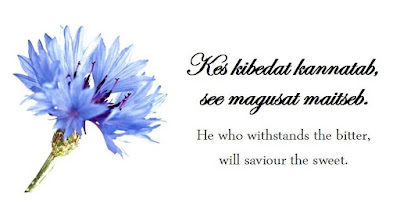Today marks 24 years since Estonia restored its independence after half a century of occupation by the Soviet regime. On this day we celebrate our freedom, reflect upon where we have come so far and look forward to a bigger and brighter future. Many noble and courageous Estonians made great sacrifices in their longing to see their beloved country free from foreign rule. It was not until 1991 that this was finally realised.
The Estonian flag raised atop of Pikk Hermann Tower is a symbol of Estonia's independence.
The Declaration of Independence from 21st February 1918 is a beautifully worded document that every Estonian should read, no matter what generation you belong to.
The Estonian Declaration of Independence written in Estonian followed by its English translation.
MANIFESTO TO THE PEOPLES OF ESTONIA
In the course of centuries never have the Estonian people lost their desire for independence. From generation to generation have they kept alive the hidden hope that in spite of enslavement and oppression by hostile invaders the time will come to Estonia "when all splinters, at both end, will burst forth into flames" and when "Kalev will come home to bring his children happiness."
Now that time has arrived.
An unprecedented fight between nations has crushed the rotten foundations of the Russian Tsarist Empire. All over the Sarmatian plains ruinous anarchy is spreading, threatening to overwhelm in its wake all the nations living in the former Russian Empire. From the West the victorious armies of Germany are approaching in order to claim their share of Russia's legacy and, above all, to take possession of the coastal territories of the Baltic Sea.
In this hour, the Estonian National Council, as the legal representative of our land and people, has, in unanimous agreement with Estonian democratic political parties and organizations, and by virtue of the right of self-determination of peoples, found it necessary to take the following decisive steps to shape the destiny of the Estonian land and people.
ESTONIA,
within his historical and ethnic boundaries, is declared as of today an
INDEPENDENT DEMOCRATIC REPUBLIC.
The independent Republic of Estonia shall include Harjumaa, Läänemaa, Järvamaa, Virumaa, with the city of Narva and its surroundings, Tartumaa, Võrumaa, Viljandimaa, and Pärnumaa with the Baltic islands of Saaremaa, Hiiumaa, Muhumaa, and others where the Estonians have settled for ages in large majorities. Final determination of the boundaries of the Republic in the areas bordering on Latvia and Russia will be carried out by plebiscite after the conclusion of the present World War.
In the aforementioned areas the only supreme and organizing authority is the democratically supported Estonian Salvation Committee created by the Estonian National Council.
The Republic of Estonia wishes to maintain absolute political neutrality towards all neighbouring states and peoples and expects that they will equally respond with complete neutrality.
Estonian military troops shall be reduced to the extent necessary to maintain internal order. Estonian soldiers serving in the Russian military forces will be called home and demobilized.
Until the Estonian Constituent Assembly, elected by general, direct, secret, and proportional elections, will convene and determine the constitutional structure of the country, all executive and legislative authority will remain vested in the Estonian National Council and in the Estonian Provisional Government created by it, whose activities must be guided by the following principles:
1. All citizens of the Republic of Estonia, irrespective of their religion, ethnic origin, and political views, are going to enjoy equal protection under the law and courts of justice of the Republic.
2. All ethnic minorities, the Russians, Germans, Swedes, Jews, and others residing within the borders of the republic, are going to be guaranteed the right to their cultural autonomy.
3. All civic freedoms, the freedom of expression, of the press, of religion, of assembly, of association, and the freedom to strike as well as the inviolability of the individual and the home, shall be irrefutably effective within the territory of the Estonian Republic and based on laws, which the Government must immediately work out.
4. The Provisional Government is given the task of immediately organizing courts of justice to protect the security of the citizens. All political prisoners shall be released immediately.
5. The city, county, and township local governments are called upon to immediately continue their work, which has been violently interrupted.
6. For maintenance of public order, people's militia, subordinated to local governments, shall be immediately organized and citizens' self-defence organizations established in the cities and rural areas.
7. The Provisional Government is instructed to work out, without delay, on a broad democratic basis, bills for the solution of the agrarian problem, and the problems of labor, of food supply, and of finances.
ESTONIA!
You stand on the threshold of a hopeful future in which you shall be free and independent in determining and directing your destiny! Begin building a home of your own, ruled by law and order, in order to be a worthy member within the family of civilized nations! Sons and daughters of our homeland, unite as one man in the sacred task of building our homeland! The sweat and blood shed by our ancestors for this country demand this from us; our forthcoming generations oblige us to do this.
May God watch over thee
And amply bless
Whatever thou undertake
My dear fatherland!
Long live the independent democratic Republic of Estonia!
Long live peace among nations!
The Council of Elders of the Estonian National Council
Tallinn, 21 February 1918




















































